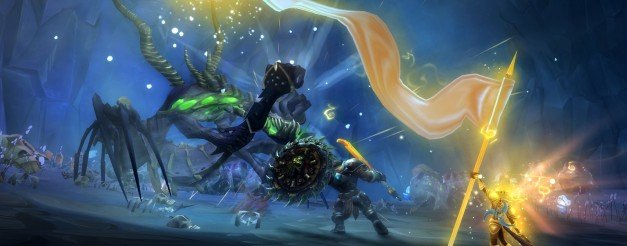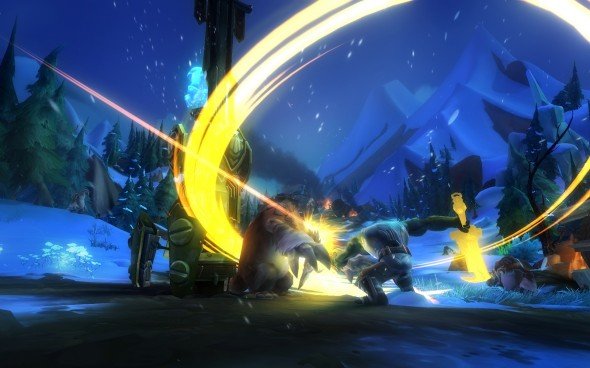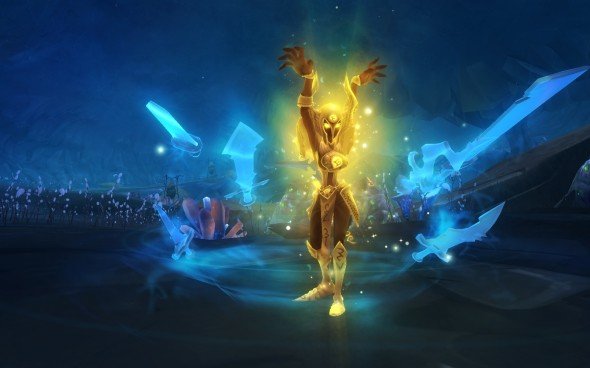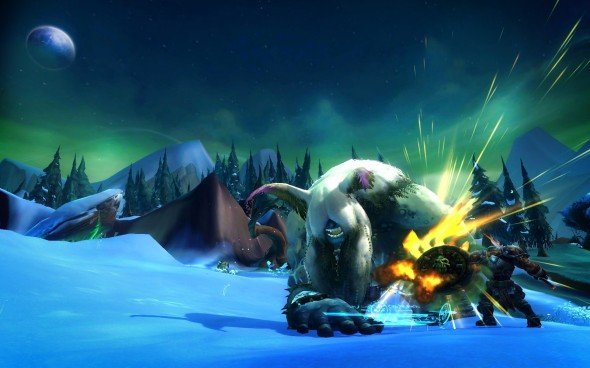WildStar preview

I'm an explorer: for me, the combat in most MMORPGs is just an annoying interruption on my way to the next cool vista or new zone. Tim, on the other hand, is more social: he runs the enormous PC Gamer Guild in World of Warcraft, and the people he raids with are the main reason he plays. Other people enjoy the rhythmic satisfaction of killing monsters and levelling up, and others again just want to scour the world for every last quest and scrap of story they can discover.
WildStar is a new sci-fi/fantasythemed MMORPG built to cater to each of those four types of gamers. It's being made by Carbine, a studio of NCsoft comprising veterans of World of Warcraft, City of Heroes, Guild Wars and a dozen more. You pick a race, a class, and then a path: a style of play that you'll stick to throughout the game.
Each one – Explorer, Soldier, Settler and Scientist – has a unique type of quest that you'll keep getting wherever you go in WildStar's world. The rest of the game is pretty close to the conventional MMO template: third-person perspective, numbered hotkeys for your ever-expanding quickbar of buffs and attacks, and friendly characters who need favours and have a few copper and some armoured trousers to pay for it.
Explorers carry a tracking device. Any time they're near an area of interest, they can use it to point them to a spot where they can place a beacon. Sometimes it's just a high point, other times it's to analyse an anomaly, and in some cases it can help out local allies – by providing targeting info for some AI-controlled snipers, for example.

All they have to do is place a beacon in the right spot to complete the quest – there's no combat involved – so the spots are accordingly tricky to get to. I found one near a gravitational anomaly that temporarily gave me super-jumping, letting me leap up to a series of high platforms. Another was only accessible via a secret route up a mesa: certain rocks are only visible to Explorers, so only they can clamber on them to reach the top. Once you've got there, placing the beacon gives you the same kind of reward as an ordinary quest in any other game: a chunk of experience.
Soldiers have a similar tracking device, but it locates outposts: areas that need to be defended from attacking enemies. Sometime's it's just a strategically important area, other times there's a group of civilians to be protected. Either way, you choose when to trigger the onslaught, and you then have to fight off wave after wave of enemies. It's not as hard as it sounds: each time I did one of these events, the attackers were much lower level than the roaming mobs of the area. You don't have to fight them alone, either: everyone in the vicinity can join in your heroic stand against the hordes, and help you survive it.
The Settler is the social path. It wasn't available in the alpha version of the game I played, so I don't know much about how its premise of 'social challenges and social rewards' actually relates to other players in the game. But only part of this path is dependent on other people: you're also helping the non-player characters of this world build villages and establish a society here. It's a path for those gamers who treat their MMORPG as a second home, and want to see that place grow and have a hand in shaping it.
Keep up to date with the most important stories and the best deals, as picked by the PC Gamer team.

The Scientist is an interesting hybrid: your quests involve collecting data from items and creatures in the world in order to learn more about its history. It's for both story-junkies and compulsive completionists: if you've ever scoured an open-world game for the last collectible item you need for the 100% completion rating, you're a Scientist. Like the Settler, it wasn't in the build I played, so I can't judge how well it caters to that mindset in practice.
The character paths double as the explanation for what you're doing here, on the exotic planet Nexus. Explorers are mapping a new world, Soldiers are here to fight bad things and save good things, Settlers have come to make a home for themselves and their people, and Scientists are in it for the research.
Nexus is the home planet of one of those hyper-advanced races that are always vanishing and leaving their mysterious technology lying around videogame worlds. In the case of the Eldan, they've left both technology and magic: WildStar fuses the two closely. The Spellsinger class, for example, dual wields pistols and enchants them to inflict different damage types. The game feels a little more fantasy than sci-fi overall, though: the other two classes I played were a sword-wielding warrior and a pure-magic illusionist.
The game's art style is a notch more cartoony than World of Warcraft, and that's actually an advantage. Game terrain tends to have a particular look to it: flat fields on which points have been reluctantly dragged into bumpy peaks by level-editing tools. WildStar doesn't look like that. These mountains look like they were arced out by brushstrokes: their summits form sharp, jagged skylines, and their slopes curve like draped cloth. It has all the character of classic handpainted animation.

One chunk of the planet is being torn apart by Loftite: a lighter-than- air mineral that lies beneath the world's surface and threatens to burst out into space. It looks like the planet is exploding in slow motion: craggy hunks of this blue crystal have ruptured the crust and dragged shrapnel twists of rock up into the air, where they hang impossibly.
The area I played was a snowcarpeted valley in a blizzard. I landed in a drop pod, Space Marine style, and stormed out. I was playing as a Granok Warrior – a big rock man with a bigger sword – but chose the Explorer path. That didn't change my main quest: beat up some yetis that are terrorising the survivors of a spaceship crash, and make my way to the mysterious tower causing the snow storm. The symbolism of playing a WoW-like MMO in which your first task is to stop a blizzard was not entirely lost on me.
The Warrior's abilities are basic close-range damage dealers and area-of- effect attacks. Some drain one of two regenerating power cells, and others require adrenaline that's built up as you do damage.
The Esper is more interesting: her basic attack summons a dozen illusory swords and flings them into your enemy. Basic attacks like this build her combo meter, which magnifies the damage of any finishing moves. One ridiculous power summons a vast imaginary hand to palm-squish your enemies from the sky, and another makes weakened enemies explode into ghosts. Playing as an Esper, I liked to palm-stun enemies, throw a few sets of swords at them to build two or three combo points, spend those combo points on a move that pretty much flings a hawk into their face, then explode them into ghosts.

The third class I tried was the Spellslinger, and I settled into a similar rhythm. He has a slow charged shot that's good to open with, since you're usually safe until you attack. A stun shot slows the enemy's approach, a twirling barrage with both pistols drains their health, and his own finishing move blows them to pieces if they're damaged enough. The animations on all these attacks have a Disney-esque flourish to them: big, expressive movements that show confidence and style.
Carbine want the experience of playing WildStar to have several layers to it at any given time. Producer Jeremy Gaffney gave the example of a quest to save some locals from alien jungle cats. You don't have to do anything more than that, but if you kill a few cats in quick succession, the game will notice and offer you a challenge: kill five more in the next two minutes, and you'll get a reward.
If you're on the Scientist path, you might notice some of these cats are mutated. Now you're scanning the mutant ones for a science quest then killing them to complete the challenge. Then you notice that the cats are hunting deer, and you have an easier time if you attack them while they're already fighting. A tribe of local druids can intervene, trying to protect the wildlife with healing spells. And if you kill them, you find an item on them that starts a quest that takes you inside an enormous tree in the area, to a cavern beneath.

“We don't believe in killing ten rats,” says Gaffney. “We believe in killing ten jungle cats and giving you four different motivations for doing it in different ways.”
It didn't always pan out quite that way for me. I did see a few layers in action: the challenges to take on more creatures within a time limit were the first time I've felt motivated to Kill Ten X. But playing the first zone through a few times as an Explorer and then a Soldier, the paths weren't as different as I'd hoped. You can skip a lot of combat as an Explorer, and that's a big bonus for me, but you always have to return to your main quest. And your main quest, as far as I played, is to kill local wildlife and save NPCs.
The character paths are still a step forward for the way MMOs adapt to the diversity of their player base. WildStar is only in alpha, with no firm release date, so Carbine may take them further still. If not, it'll just be a very pretty world with a few cool new ideas. I can live with that

